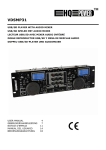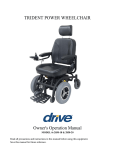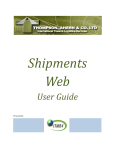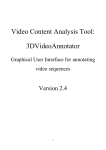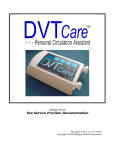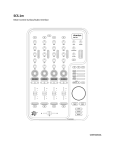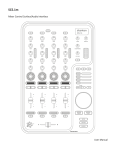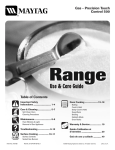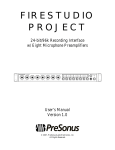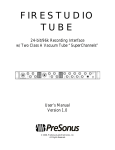Download Stanton SCS.1d CD Player User Manual
Transcript
SCS.1d d Deck Con ntrol Surface e USSER MANU UAL Important Safety Instructions • Read and follow the provided instructions before operating this unit. • Adhere to all warnings and security advices, and retain this document for future reference. Installation: Install the unit in accordance with the provided instructions Power Supply: • The unit should be connected to a power supply outlet only of the voltage and frequency marked on its rear panel. • The power supply cord should be routed so that it is not likely to be walked on or pinched. • The power supply cord of the unit should be unplugged from the wall outlet when it is to be unused for a long period of time, or during electrical storms. Placement and Environment: • Locate the unit away from direct sunlight and any equipment that produces heat such as power supplies, amplifiers, and heaters. • Place your mixer on stable surfaces, away from vibration and from sources that generate hum or noise, such as transformers, or electric motors. • The location and position of the unit should not interfere with its proper ventilation. • Do not use this unit near water. For example, near a bathtub, washbowl, kitchen sink, laundry tub, in a wet basement, or near a swimming pool. • To reduce the risk of fire or electric shock do not expose the equipment to rain or moisture or use it in damp or wet conditions. • Protect the unit from excessive dirt and dust. • Avoid drinks spillage, tobacco ash, and smoke (especially that associated with smoke machines). • Do not place heavy objects on the unit surface. Cleaning: Unplug the unit from the wall outlet before cleaning. Never use benzene, thinner, or other solvents for cleaning. Use only a soft damp cloth. Service: • The unit contains no user‐serviceable parts. • The manufacturer is not responsible for any damage or personal injury resulting from unauthorized user servicing or modifications. Please read the warranty. • The warranty will be void if any unauthorized service by the user is detected. • If service is required, please contact Stanton Tech at +1 954.316.1500 (Option 3) ii Table of Contents 1. Introduction .......................................................................................................................................................... 1 1.1 Welcome to the SCS.1d!............................................................................................................................... 1 1.2 Overview ...................................................................................................................................................... 2 1.3 Unpacking ..................................................................................................................................................... 2 2. Connecting the SCS.1 ........................................................................................................................................... 3 2.1 Connecting to Your Computer ..................................................................................................................... 3 2.2 Connecting to the SCS.1d to the SCS.1m ..................................................................................................... 4 2.3 SCS.1d Setups ............................................................................................................................................... 4 3. SCS.1d Description ............................................................................................................................................... 5 3.1 Top Panel Functional Groups ....................................................................................................................... 5 3.2 Encoder Section ........................................................................................................................................... 7 3.3 Trigger Section ............................................................................................................................................. 7 3.4 Platter / Global Section ................................................................................................................................ 8 3.5 Pitch Section ................................................................................................................................................. 9 3.6 Transport Section ......................................................................................................................................... 9 3.7 Preset Switcher Section ……………………………………………………………………………………………………………………… 10 4. SCS.1 Software Installation ................................................................................................................................ 11 4.1 Windows XP ............................................................................................................................................... 12 4.2 Mac OS X .................................................................................................................................................... 19 5. DaRouter ............................................................................................................................................................ 23 5.1 About DaRouter ......................................................................................................................................... 23 5.2 Anatomy of DaRouter ................................................................................................................................ 23 5.2.1 Section A ................................................................................................................................................ 24 5.2.2 Section B ................................................................................................................................................ 24 5.2.3 Section C ................................................................................................................................................ 26 5.3 Using DaRouter .......................................................................................................................................... 27 5.4 Loading a Preset ......................................................................................................................................... 27 5.5 Using a Preset for the First Time ................................................................................................................ 27 6. Troubleshooting ................................................................................................................................................. 28 7. Specifications...................................................................................................................................................... 29 Appendix ..................................................................................................................................................................... 30 Optimizing Computers for 1394 (FireWire) ............................................................................................................ 30 DPC (Windows XP‐Vista) ..................................................................................................................................... 30 Windows 1394a Bandwidth Limiting Issue / SidSpeed Fix (Windows XP‐Vista) ................................................. 35 FireWire Chipsets ................................................................................................................................................ 45 iii 1. Introduction 1.1 Welcome to the SCS.1d! Thank you for purchasing SCS.1d! The SCS.1d (Stanton Control System 1 deck) is the premier deck control surface for laptop DJs, remixers, VJs, and producers. Before we begin, there are a few important issues we would like to bring to your attention. There is a software component to this hardware. It is called DaRouter. DaRouter is a kind of “MIDI processor” that allows the use of presets. These presets can be application specific mappings, or generic maps that can be applied to a number of different software packages. In fact, you may already be familiar with the DaRouter software because it is also used with our SCS.3 line of controllers. Well, DaRouter is even more important for the SCS.1 controllers than it is for the SCS.3 controllers. This is because the DaRouter software for the SCS.1 controllers also contains the driver for them. So it is important for you to go to http://www.enterthesystem.com/scs1 to download and install the latest DaRouter software. This single software package gives you the latest presets and the latest version of your driver. Be sure to keep your DaRouter software updated so you can take advantage of new presets and features as they become available! This brings us to the next important issue. Please do not connect the SCS.1 hardware to your computer before you go through the driver install. Most audio interface installers, FireWire or USB, carry the same warning. We know that when you buy new gear, most people are excited to hook it all up and see what it can do, but in this case, it is better to wait until you are prompted. The process will go like this… • You should connect the power to your SCS.1d and locate the FireWire connector, but do not connect it to the computer yet. • Download and run the DaRouter installer for the SCS.1d. This installer is located at www.enterthesystem.com/scs1 • On Windows a dialog box will open telling you to connect and power up your SCS.1d. At this point, connect the FireWire cable to your computer. On a Mac computer you will just need to install DaRouter first, however no dialog will show for connecting the units. The driver will then detect the SCS.1 devices connected to your computer and load the drivers for them. Allow the installer to continue normally. Following these steps is a good idea for any hardware installation you have, and might save you from possibly having to troubleshoot a problem later. Finally, we would like to point out that the descriptions of specific functionality of the SCS.1d are generic. The SCS.1d is a MIDI controller and does not generate any audio itself. Although it looks like a CD player or turntable, it in fact is not. The functionality of a given control on the surface of the SCS.1d (like the pitch slider for example) is dependent on what it is assigned to. We had to start somewhere, so we thought it would be best to describe the functionality of the generic preset. When you are using other presets, you can click on the Preset Documentation button in DaRouter (it’s the “?” button) to learn all about how that specific preset works with your new SCS.1d. 1.2 Overview The SCS.1d was designed for high‐precision software control. Thanks to its straightforward interface and intuitive ergonomics, the SCS.1d provides a host of top‐notch features at your fingertips, such as high‐torque 10” motorized platter, 100mm motorized pitch fader, velocity‐sensitive pads, assignable encoder sections, and much more… The SCS.1d (deck) and the SCS.1m are the main components of the SC System 1; Stanton‘s most advanced digital control system for the professional DJ. You can use the SCS.1d in conjunction with the SCS.1m for tight integration and full control of your DJ/VJ application’s main parameters or with other audio interfaces. • • • • • • • • • Adjustable high‐torque 10” motorized platter with vinyl surface and superior tracking. High‐resolution vinyl tracking system allows for super‐accurate mixing and scratching. 100mm pitch fader motorized to maintain sync with software. 4 Velocity‐sensitive pads assignable to loops, cue points, etc. Assignable Encoder section with 360° of LED feedback. LCD “scribble strips” for two‐way communication with selected software. Familiar Transport section for direct music control. Perfect for adding maximum control capabilities into existing DJ software. Easily controls multiple virtual decks for powerful multi‐channel mixes. Before you start hooking up your new unit, let’s check what is in the box! 1.3 Unpacking Please check that you have received the following items: • (1) SCS.1d unit • (1) FireWire cable • (1) 4 to 6 pin FireWire adapter • (1) Power cable and adapter (24V) • (1) Felt slipmat • (1) Vinyl control disc • (1) SCS.1d Manual Upon unpacking the SCS.1d, you should place the slipmat on the platter and then place the record on top of the slipmat. In addition to the above items, remember that to take advantage of the SCS.1d full potential you will need the SCS.1m or a traditional DJ mixer, a Mac or PC computer, a DJ application, and to download and install DaRouter software. So let’s get started! 2 2. Connecting the SCS.1 2.1 Connecting to Your Computer Step 1: Locate the included power cable and adapter (24V) and connect it to the SCS.1d and to your power source. (Figure 2.1) Note If you own both the SCS.1m and the SCS.1d, the power adapters look very similar. Looking at the output voltage will tell you which is for which component, (e.g., 12V for the SCS.1m, and 24V for the SCS.1d). There is also a label on each of the power cords to specify which product they are to be used with. Figure 2.1 Step 2: Attach the included FireWire cable to the SCS.1d. The FireWire ports are clearly labeled on the back panel of the SCS.1d. (Figure 2.2) Figure 2.2 Step 3: Download and run the DaRouter installer for the SCS.1d. A dialog box will open telling you to connect your SCS.1d. At this point, turn the SCS.1d on and connect the FireWire cable to your computer’s FireWire port (Figure 2.3). Do not connect the SCS.1d until prompted. Figure 2.3 On laptops, there are two different types of FireWire ports: 6 and 4 pin. Typically, you will find “full sized” 6 pin ports on Apple laptops. If your computer has a full sized (6 pin) FireWire port, use the included FireWire cable to connect directly from the SCS.1d to your computer. Most PCs will have a 4 pin FireWire port. So if you have a 4 pin port on your computer, connect the FireWire cable to the provided 4 to 6 pin adapter, and then just plug it to your computer’s 4 pin FireWire port. Now that power and FireWire are connected, we can explore hooking up the SCS.1d with the SCS.1m (if used). 3 2.2 Connecting to the SCS.1d to the SCS.1m All of the SCS.1 controllers have two FireWire ports on them, so devices can be chained together if needed. So when connecting a single SCS.1d to the SCS.1m, you would go from the unused FireWire port on the SCS.1m (Figure 2.4), (the other port is connected to your computer) to an open port on the SCS.1d. (Figure 2.5) Figure 2.4 Figure 2.5 Likewise, if you’re connecting two SCS.1d’s to a SCS.1m, then you would go from the free FireWire port on the first SCS.1d to a port on the second. Any other FireWire devices should go at the end of the chain and not before any of the SCS.1 controllers. Let’s take a look of the SCS.1d Setups. 2.3 SCS.1d Setups The following configurations can be used for the SCS.1d for typical use cases: SCS.1m + SCS.1d This mixer‐and‐deck configuration can be used to emulate a dual‐deck setup by using virtual decks for controlling transport, loop, and effects, while using the mixer to blend and EQ songs and sounds. This system is the perfect entry into the world of professional SC System laptop mixing. (Figure 2.7) Dual SCS.1d + SCS.1m This setup recreates the “traditional” DJ system, allowing users to have two physical decks, each representing an on‐screen deck (which can easily be toggled to four decks by using virtual decks). The mixer is used for blending, channel EQ, etc, in a traditional manner. This setup is tailored towards professional DJs wanting to replace their existing setup with an SC System controller‐based solution. (Figure 2.8) Figure 2.8 Single / Dual SCS.1d + traditional DJ mixer The SCS.1d(s) can be used with an existing sound card to send audio outputs from DJ software into an existing analog DJ mixer. This allows users to incorporate SC System decks into their system while using their favorite traditional DJ mixer (Figure 2.9). 4 Figure 2.7 Figure 2.9 3. SCS.1d Description In this chapter, we will briefly describe the top panel of the SCS.1d. It’s important to understand that the SCS.1d is a traditional DJ turntable / CD player “analogy” in a control surface. This means that while the SCS.1d looks like a DJ turntable / CD player, at its core, it is really a control surface that sends and receives control data to and from a computer. As a control surface, the SCS.1d’s functionality is completely derived from the host application (software) that it is controlling. The SCS.1d also utilizes presets in DaRouter to define its capabilities, which can drastically change its functionality depending on how the preset is configured. So as we discuss the panel and layout it is important to remember that when running a specific preset its best to read the documentation associated with that preset as it will explain how the SCS.1d is tailored towards the application it is being used with. So in the below explanations we describe the controls and how they traditionally may be mapped into an application. 3.1 Top Panel Functional Groups To easily understand the main SCS.1d Top Panel, we have divided it in six functional groups: ‐ Encoder Section ‐ Trigger Section ‐ Platter / Global Section ‐ Pitch Section ‐ Transport Section ‐ Preset Switcher Section On the next page, let’s take a look of the Figure 3.1: 5 oups (continuaation) Top Panel Functional Gro Figure 3.1 ook of each of the functional groups. Now, let’s take a closer lo 6 3.2 Encoder Section This section consists of four rotary push encoders, each with an LED encoder ring to indicate the value of the encoder, and an LCD “scribble strip” that can be used to indicate the functionality of each encoder. Encoders are used to control variable parameters such as effect levels. Encoders do not physically stop when you turn them; instead the LED encoder rings indicate the position of the control you are adjusting. 3.3 Trigger Section The trigger section consists of four velocity sensitive pads, four LCD “scribble strips”, and seven clicking switches. Each pad, switch and screen is backlit by multicolor (red, green, orange) LED’s. The velocity sensitive pads and switches are typically assigned to trigger actions such a playing cue points, moving loops or killing frequencies. The LCD “scribble strips” will display functionality and status depending on the preset. 7 3.4 Platter / Global Section This section controls the assignment of the platter as well as global functionality. The DECK SELECT button will allow you toggle virtual decks on screen. In this way when you switch virtual decks, the SCS.1d will also change its state to match the on screen deck. By using one physical SCS.1d you can control multiple virtual decks. The VINYL, CONTROL and BROWSE buttons all modify the motorized jogwheel’s functionality within the application. The motorized platter is normally used for scratching and scrubbing through a song when “VINYL” is activated. However, the Control button allows the platter to be freely used as a large parameter control such as scratching an effect. BROWSE is used to scroll the playlists in applications that support mapping to browser view. Depending on the control mode the ENTER and CANCEL buttons will allow for expanded functionality with the platter. SETUP button will allow for adjustments of the overall deck controller. Upon pressing setup you will see the current firmware version. Using the first encoder will allow you to select a value to change; the second encoder will allow you to adjust the value. ‐ Contrast: Adjusts the contrast of the LCD screens. ‐ Torque: Adjusts the torque of the platter to simulate different turntables. ‐ MIDI Ch: Changes the output MIDI channel of the device. It is suggested NOT to change this as presets usually expect the deck to send data from the default MIDI channel. ‐ Decay: Adjusts the acceleration curve of the encoders. 8 3.5 Pitch Section The pitch section represents a traditional pitch control found on a CD player or turntable. However, the key difference is that the pitch control is motorized to support functionality such as auto‐sync in an application and updating position when switching virtual decks. It’s important to not stop the motorized fader while it’s moving to prevent damage. The RESET button will center the pitch slider to 0% automatically. The RANGE button will change the sensitivity of the pitch slider (as long as the application supports the ranges). 3.6 Transport Section The transport section is analogous to the transport controls on a CD player however it places a few extra buttons for common functions found in DJ applications (such as auto sync). Each of the 4 main transport buttons are multi color back lit to indicate status. Along with the 4 main transport buttons are seek forward and backwards as well as scan forward and backwards. Above the seek and scan buttons is a freely assignable backlit button. 9 3.7 Preset Switcher Section The preset switcher section controls switching of presets on the SCS.1d. Presets are generally related towards switching presets for the encoder section, trigger section or pitch slider. Presets are groups of controls with functionality focused towards doing a single task. For instance, a loop preset will contain all the controls needed to create, move and modify a loop. Preset configuration and functionality are highly dependent on the application the SCS.1d is being used with. As with the rest of the controls it’s very important to read the preset documentation from within DaRouter for information on how the unit is configured. 10 4. SCS.1 Software Installation Before installing the SCS1 software (DaRouter and drivers) make sure you follow these guidelines: 1) Windows: Do NOT connect the SCS.1 controller(s) until prompted by the driver installer. 2) Windows: When intending to use multiple SCS.1 controllers at once (mixer + decks) make sure you connect ALL the devices during the driver installer. 3) Always check the Stanton website (listed below) for the latest drivers and firmware. To fully maximize SCS.1 capabilities and take advantage of its great features, some software needs to be installed with it. In fact, the SCS.1 Software Installation process differs greatly between Mac and PC computers. ‐ On a Mac, the SCS.1d is a class compliant FireWire device, which means that it will connect to the system without drivers, however, because the SCS.1d uses a proprietary high speed MIDI system it is necessary to install DaRouter to communicate with the SCS.1d and create a virtual MIDI port for the host application to receive MIDI messages through. On the Mac you will simply need to install DaRouter, connect the unit(s) and start using your desired preset. ‐ In Windows, a high level FireWire driver must be installed to communicate with the SCS.1d. Once this driver is installed the SCS.1d and can communicate with DaRouter. Upon installing DaRouter, both the FireWire and virtual MIDI port driver are installed. It is important to not connect the SCS.1d until prompted. It is also important to connect all units that will be used when installing the driver (if using multiple SCS.1d’s or with a SCS.1m). In either case, (Mac or PC) the DaRouter software needs to be installed. This software acts as an intermediary between your SCS.1 controllers and your performance software, intercepting and processing MIDI messages before sending them out to your application of choice. This process takes less than a millisecond, and gives you some amazing power. Not only does it allow you to quickly change the MIDI output of the SCS.1 controllers (by switching presets), it also allows for logic‐based programming that your performance software may or may not be capable of performing. This means that it is actually possible to add or change some functionality in your software of choice. This can be as simple as adding MIDI data to an application that does not normally support it, to totally changing the behavior of a given control. In short, if you are a PC user, you will run one installer that will install the SCS.1 driver and DaRouter. If you are a Mac user, you do not need to install any driver but you must install DaRouter. Before walking through specific installation procedures for Mac and PC, you will need to download the latest version of DaRouter from the Stanton website: www.enterthesystem.com/scs1 So, let’s follow the specific instructions for each platform. 11 4.1 Windows XP 1. Double click the executable file (.exe). If the following Open File‐ Security Warning appears, click Run. (Figure 4.1) Figure 4.1 2. The Stanton SCS.1 DaRouter Setup Wizard will guide you through the installation process. Click Next. (Figure 4.2) Figure 4.2 12 3. To install the software for the first time, choose the Standard option. To update your previously installed version, choose Custom. In this example, let’s choose Standard. (Figure 4.3) Figure 4.3 4. Read the License Agreement, select the “I accept the agreement” option, and then click Next. (Figure 4.4) Figure 4.4 13 5. The installation of the ASIO / high level FireWire driver will begin. When you are ready, click Next. (Figure 4.5) Figure 4.5 6. In this step, you are able to choose where to install the driver. However, if you do not really need to change the location, leave the default setting and click Install. (Figure 4.6) Figure 4.6 14 7. Files will begin to copy or if you are installing a new driver the old drivers will be uninstalled before new files are copied. When prompted to connect your devices (Figure 4.7), turn ON all SCS.1 devices to be used and then connect the FireWire cable from the device(s) to your computer and click OK. Figure 4.7 8. Wait for a few seconds, normal operation will resume shortly. (Figure 4.8) Figure 4.8 15 9. Once the files are done copying click Next to continue. (Figure 4.9) Figure 4.9 10. Click Finish. (Figure 4.10) Figure 4.10 16 11. Read information regarding this build of the installer then click Next. (Figure 4.11) Figure 4.11 12. Click Finish. (Figure 4.12) Figure 4.12 That’s it. You have installed the SCS.1d driver and DaRouter. 17 drivers and sofftware are pro operly installed d, open Device e Manager. On n your desktop p, right To cheeck that your d click M My Computer icon and click Properties. In n the System P Properties win ndow, click thee Hardware tab, and then the Device Man nager button. (Figure 4.13) Figure 4 4.13 You w will see a new section called Stanton 1394 4 Audio Devicees that includes the Stanton 1394 Virtual D Device and a hardware specific driver for each controlleer you have co onnected. Checck that the SCSS.1d device (orr other SCS.1 devices such aas a mixer) are attached to yo our computer. You caan also click the Start button and verify thaat all associated d applications appear there. (Figure 4.14) Figure 4 4.14 You w will see a driver program group, along with aan SCS.1 DaRouter icon. Thatt is it. You are d done! 18 4.2 Mac OS X To install DaRouter, first make sure that your SCS1 controller is not connected and then follow the next instructions 1. Double click the .dmg file to expand it. (Figure 4.16) Figure 4.16 2. Double click the DaRouter.pkg file to start the installer. (Figure 4.17) Figure 4.17 19 3. Once the installer has started, click Continue. (Figure 4.18) Figure 4.18 4. Read the license agreement and click Continue. In the next dialog, click Agree. (Figure 4.19) Figure 4.19 20 5. Next, you can set the default path of the program. Click Install unless you want to install DaRouter to a specific destination. (Figure 4.20) Figure 4.20 6. DaRouter will be installed. Once done, click Close. (Figure 4.21) Figure 4.21 21 7. DaRouter will be installed into your Applications folder and the presets will be placed in your home directory. Plug in your SCS.1 controller, power it ON, connect the FireWire cable to your computer, start DaRouter, and read the rest of this documentation. (Figure 4.22) Figure 4.22 Now that you have installed DaRouter, let’s learn about it. 22 5. D DaRouter 5.1 Ab bout DaRoutter nton and Bomee’s Software, w which allows tthe SCS.1 devices to DaRouter is an application developed between Stan d interact with audio applicattions. DaRouteer takes incoming messages ccoming from aa SCS.1 specificallyy integrate and device usin ng a proprietarry high speed m messaging pro otocol and tran nslates them to o the host targget audio application through th he form of pre esets. This traanslation proceess allows thee unit to change its function nality dependiing on which mode the unit is in and the desired host application functionality. Every E single action a on the SCS.1 d through DaR Router, which means that as application ns evolve, so do presets… More controllerss is processed importantlly, presets can be created an nd edited freely with virtuallyy no limit to w what SCS.1 controllers can do o, thus opening up p a whole elem ment in contro ol surface DJingg. It is importaant to constanttly check the SStanton websitte and forums forr new presets. 5.2 An natomy of D DaRouter plication they aare being used d with. DaRouter iis the brains behind interaction between SSCS.1 controlleers and the app DaRouter is designed to o sit in the bacckground and just translate MIDI but does have some functionality f to o load nd configure yo our SCS.1 controllers with DaRouter/Activ D ve preset. Befo ore we load a preset, let’s take t a presets an quick tour of what everything inside off DaRouter doees. To easily describe DaaRouter, we divided its interface in three sections: A, B, and C respecctively. 1) (Figure 5.1 Figure 5.1 23 5.2.1 ection A Se ‐ Active Preset D A Dropdown The Active Presset is the currrently used preeset. In this drop down menu, all dragged or maanually pre‐installed prresets will be liisted as well ass any presets d oaded into DaRouter. To loaad a preset intto DaRouter, just j select onee from lo th he list. A the bottom of the drop down list is a Browse At B listing that can be ussed to m manually brows se a preset usin ng a file explorrer dialog. R Restart Preset B Button The Restart button will startt the currentlyy running presset. This should not ou the option to restart a p preset in case o of any need to be useed, but gives yo problems. Figure 5.2 Button Preset Doccumentation B The Presett Documentation button (sho own as “?”) wiill load the HTML documentaation associateed with the selected preset. The preset documentation inccludes all the setup s instructions for using the preset witth the application it ned for. To fullly take advanttage of the SC CS.1 capabilitiees it is stronglyy recommendeed to click the Preset was design Documenta ation button and read its con ntent every tim me that you loa ad a new preset. (Figure 5.2) ection B 5.2.2 Se D Device Configu uration T This section in dicates if a device is required for use with a preset, and if that d device is conn nected. For “Siingle” presets,, only one devvice is requireed. For “ “Dual” presetss, two devicess are required. When a devvice is not used in a preset, the image will be ghosted. When aa device is useed, the image w will be g gray, and wheen the device is detected (plugged ( in), it will glow blue to i indicate conne ectivity. D Device Dropdo own T device drropdown menu will list anyy detected devvices by their serial The number. Seleccting a device w will assign it to the deck used d in the preset. Once t this assignmen nt is made, DaRouter will rem member the asssignment for future use so you do not need to asssign the device each time. (FFigure 5.3) Figure 5.3 Options h Device Dropdown menu th here is a button called Option ns. Clicking on it will allow yo ou to change several Below each important settings. 24 For example, if you click the SCS.1m Options button the SCS.1m Audio Control Panel will open so you will be able to Start and Stop the streaming process, access the Deferred Procedure Calls (DPC) Latency Checker (for more information please read the Appendix), and select the Sampling Rate, FireWire Latency, and ASIO Buffering settings. (Figure 5.4) Start / Stop Streaming – Use this to start or stop the audio stream between the driver and hardware. If streaming has been stopped, then no audio will be passed to the hardware. DPC Latency Tool – Stanton includes a troubleshooting tool for detecting high DPC latency. When there is high DPC latency apparent on a machine it can affect the performance of audio and MIDI streaming. You must have low DPC latency to achieve consistent performance and low latencies. Figure 5.4 Sampling Rate – Sampling rate will set the resolution of the audio coming from the outputs of SCS.1m. Higher sampling rates mean more audio fidelity but also more processing on the computer and should only be used on newer machines. Another consideration is the material being played. For instance, 96 kHz should only be used if your source audio is high resolution whereas 44.1 kHz or 48 kHz should be used for MP3’s and CD quality content. FireWire Latency – This sets the latency or speed in which audio is sent to the hardware. Low latency will make the controls feel “snappier.” However, your computer must be able to support these low speeds. If the computer cannot support low latency, then audio hiccups or “drop outs” might be observed. If low latency is not achieved with a high‐end machine, it is suggested to use the DPC tool and follow the instructions in Appendix for system optimization. ASIO Buffering – This controls the buffers used between the driver and host application. Low buffering will mean higher speed / lower latency but requires a high‐end computer. 25 Now, if you click the SCS.1d N d Options button the SCS.1d Control Panel will o open, so you w will be able to cchange the Scrratch Engage, the Scratch Reelease, a and Pitch Bend d Sensitivity values. (Figure 5.5) S Scratch Engagge Sensitivity – The SCS.1 1d uses an algorithm a to detect d s scratching to accommodatte MIDI scraatching implementation in host a applications su uch as Traktor. The Scratch Engage slider will set how q quickly t scratch alggorithm will detect that you the u are trying to o perform a sccratch. H Higher settingss will make th he algorithm more m snappy. However, if yo ou set t this value too high you run tthe risk of misstriggering a sccratch messagee with t the slightest va ariance in record speed. S Scratch Releas se Sensitivity –– This slider co ontrols how qu uickly the SCS.1 1d will d detect the rec ord being releeased and catcching up to speeed with the p platter t thus entering regular playbaack mode and d disabling scrratching in thee host a application. Figure 5.5 Pitch Bend d Sensitivity – – The SCS.1d also has the ab bility to detectt when the plaatter is being rubbed manuaally by hand to slo ow or speed th he track up. Th his is detected d when the plaatter and recorrd change speeed at the samee time (whereas w with scratchingg the platter kkeeps spinning at its set speeed). Setting this value will ch hange the senssitivity and once again, makingg it too sensitiive might cause mistriggerss of the pitch bend messagee going to thee host application n. ection C 5.2.3 Se Activity Mon nitor The activityy monitor indiccates messages flowing in an nd out of DaR Router. The first arrow indicatees an incomin ng message. The T DaRouterr icon he last arrow in ndicates an outtgoing indicates a ttranslation occcurring, and th message. The images will glow blue to o indicate theyy are processiing an action. Logos hey do link to w websites. Just for bling... actually, th Version outer. (Figure 5 5.6) This displays the current vversion of DaRo Figure 5.6 26 5.3 Ussing DaRouter ng DaRouter, there are two b basic types of presets that yyou may utilizee; generic and application sp pecific. When usin The generic preset allow ws you to con nfigure the app plication to th he SCS.1 contrrollers through h conventional MIDI wever, the application speciific presets aree designed to work specificcally with certaain application ns and Learn. How provide loggic in the SCS.1 1 controllers th hat is focused ttowards that application. 5.4 Lo oading a Presset hat no preset iss loaded and yyour SCS.1 conttroller(s) is con nnected. At thiis point, you m may select the preset Confirm th you wish to use and then n read its inclu uded documentation by clicking the “?” buttton. Also, rem member to cheeck the w for the e latest presetts as they are constantly beeing updated to t support neew functionalitty and Stanton website application ns! 5.5 Ussing a Presett for the Firsst Time depending on w which applicatiion you are using DaRouter w with. 1) Select the desired prreset you would like to use d nobs on the SC CS.1 controllers, to confirm feedback is making m its way into 2) Move any faders, switches or kn uter and the un nit should load d the preset and stop flashingg. DaRou 3) Now yyou are ready tto use the presset. o read its inclu uded HTML do ocumentation which Important Click the “?” button next to the preset (Figure 5.7) to n and the functtionality of thee SCS.1 controllers with that p particular presset. explains seetting up the host application Figure 5.7 bout the specifiic SCS.1 presetts always checkk the Stanton w website for thee latest presetss and For more information ab documentaation. 27 6. Troubleshooting 1. I have both the SCS.1m and SCS.1d, and when I try to power them up nothing happens. What is wrong? You probably have the power supplies for each controller swapped. If you plug the wrong power cord into a unit, it won’t power up. The power cable for the SCS.1m supplies 12V, and the one for the SCS.1d supplies 24V. You can also tell which is which by the color‐coding. For example, gray for the SCS.1m and blue for the SCS.1d. 2. Can I use the FireWire cable alone to power the SCS.1 controllers? No, the SCS.1 controllers require external power. We intentionally wanted power to be supplied to guarantee that consistent performance is achievable as not all bus power on the FireWire port is stable across machines. 3. I cannot find the driver for my controller. In Windows, the driver installer is combined into the SCS.1 DaRouter software. In OS X, the SCS.1m controllers is Core Audio compliant and doesn’t need a driver, however both the SCS.1d and SCS.1m require DaRouter to translate their control data into MIDI. As stated in the installation procedure, make sure you download the latest driver from the Stanton website. 4. My computer does not have a 6 pin FireWire port on it. Use the 6 to 4 pin adapter included in the packaging. 5. My computer doesn’t have a FireWire adapter at all. In most cases, a FireWire interface can be easily added to a computer. For laptops, you need to look for either a PCMCIA or ExpressCard based adapter (which one to use depends on the card slot your computer is equipped with). For desktops, you should use an add‐in PCI FireWire card. Please do not use a USB‐to‐FireWire adapter cable because it will severely degrade performance. Check the appendix of this manual for suggestions on choosing a FireWire card. 6. I am getting click and pops in my audio. This can be many things. Do you hear noise even when there’s no software playback? If so, then the cause is likely a ground loop (especially if it goes away when running the computer on battery power). If not, does increasing the buffering in the driver make the problem go away? If so, then it could be an issue with your system performance. For OS tweaks, please read the Appendix Optimizing Computers for 1394. If neither of the previous options seems to fix the issue, let’s try a couple of more alternatives. Do you have multiple FireWire devices connected? If so, try using just the SCS.1m. If that addresses your issue, then try re‐ordering the devices in the FireWire chain. You should always have the SCS.1 controllers “closest” to the computer and plug other devices (drives, etc) into them (or run your drives on a separate port altogether). If you’re running Windows XP, you might need the SidSpeed fix outlined in the appendix of this manual. To contact Tech Support, please call us at +1 954.316.1500 and select the SCS.1 option. 28 7. Specifications Motor Type Motor Speeds Starting Torque Start / Stop Time FireWire Speed Power 16 Pole, 3 phase, brushless DC motor 33 1/3 rpm, 45 rpm >4.5 kgf.cm .2 seconds FireWire 400 24 VDC / 3.0 Amps 29 Appendix Optimizing Computers for 1394 (FireWire) When using any computer for live audio applications it is always suggested to perform certain optimizations to ensure consistent performance. For the most part live audio is not always the highest consideration for both hardware designers and software programmers. With that being said, Stanton has put together this guide and included one of the most widely used troubleshooting tools (DPC Latency Checker) with the SCS1 to help optimize your computer by performing certain tweaks, which we have found increases performance and stability substantially. If you are having issues getting your computer to recognize the SCS.1 controllers then it is suggested to start with the SidSpeed fix. If you are having issues with audio performance (drop outs) then it is first suggested to perform the following steps: • Disable wireless internet devices • If running Windows on a Mac (Boot Camp), kill the process “KbdMgr.exe” • Disable ACPI • Perform DPC checks (below) • Perform the SidSpeed fix (below) • Check the brand of 1394 host controller you are using. Please read the next page about the (DPC) Latency Checker. DPC (Windows XP‐Vista) During the SCS.1 driver installation process, we are also installing the Deferred Procedure Calls (DPC) Latency Checker. This useful Windows application not only analyzes how your computer is handling real‐time data streams but also helps you to find the potential cause for drop‐outs (interruptions in real‐time audio and video stream). In fact, the DPC Latency Checker will allow you to find out the driver that causes the excessive DPC latencies so then you are able to disable it through the Windows Device Manager. In other words, using this application will help you to optimize your system so everything runs smoothly while using the SCS.1 controllers. Let’s take a look of its main window. (Figure A.1) 30 Figure A.1 The green Bar Graph shows the curreent latency value over time. Each bar reprresents the maaximum DPC laatency within one seco ond. Every seccond, bars are scrolled from right to left an nd a new bar iss added at thee right‐ occurred w hand side, (representing the most receent value). DPC Latency Checker updates its internal statistical data at an intervval displayed as Test Intterval. The Curreent Latency value indicattes the maxximum DPC latency meassured within the last seecond. The Absollute Maximum m value reprresents the maximum m lateency measureed since the tool was sttarted. Click Resett to clear this vvalue. To stop thee Latency click Stop, and to eexit the applicaation click Exit.. 31 ple, a typical prroblem is show wn in the next ffigure. Red bars indicate exceessive DPC lateency. (Figure A.2) For examp Figure A.2 nager to find o out the driver tthat causes thee excessive DPC C latencies. On n your desktop p, right So let’s open Device Man perties. In the System Prope erties window, click the Hard dware tab, and d then click My Computer icon and click Prop click the Device Manager button. In the next page, please check Figgure A.3. 32 Figure A.3 ore you start finding f out wh hich device cou uld be the cau use of the exccessive DPC lattency, please follow Now, befo these sugggestions: d not disable: You should ager under Sysstem devices orr Computer • any device listed in Device Mana on • the hard disk that contains the ssystem partitio • the IDE/ATAPI or SSATA controlleer this hard diskk is connected to • the system keyboaard point or touch pad device • the mouse, track p board and/or m mouse devices are connected d to • the USB controllerr external keyb oller listed undeer Display adap pters • the display contro Try to disable the followiing devices firsst: work adapterss for Ethernet aand Wireless LA AN (W‐LAN) • Netw • ACP PI Power Management • Inteernal modems • Inteernal sound devvices (on‐board d sound system ms) • Anyy PCI or PCI Exp press add‐on ccard, any PCCaard or ExpressC Card, e.g., TV ttuner cards, ISDN or DSL adaapters, mod dems, etc. 33 will be To disable a device, rightt‐click on it (e..g. on the Etheernet adapter) and choose Disable. The dissabled device w marked with a red cross. (Figure A.4) Figure A.4 Now, cheeck the DPC Latency Checker to see if the excesssive latency values (red bars) disappeeared. If yes, we have found th he problem, if not, try the neext device. To enable a deviice again, choo ose Enable fro om the context meenu. have identified d the device drriver which is responsible for the dropouts,, visit the devicce vendor's Weeb site After you h or contact its Customer SSupport deparrtment to find an update for this driver. If tthere is no upd date available at the e to disable thaat particular deevice while you are using streaming applicaations. moment, yyou may decide 34 Windows 1394a Bandwidth Limiting Issue / SidSpeed Fix (Windows XP‐Vista) First, let’s explain a little about what the SidSpeed Fix is. Basically, SidSpeed is a value in your windows registry that regulates the speed of your FireWire bus. It can have a value from 0‐3 (0=S100 speed, 1=S200 speed, 2=S400 speed, and 3=800 speed). If a SidSpeed value larger than 3 is used, then Windows will reject that and use a value of 0 instead, so it’s important to use a value of 0‐3. Normally, the default value for SidSpeed is 2, which corresponds to a transfer rate of 400 mbps (FireWire 400). This speed is standard for most audio interfaces, including ours. The problem is that there are situations where this value can be lowered to “0” during an OS update and result in choppy and unusable performance for streaming audio. This issue seems to have first been encountered in the SP2 update for Windows XP… http://support.microsoft.com/kb/885222 …and came back again with the XP SP3 update. http://support.microsoft.com/kb/955408/en‐us We’ve also seen incorrect (or no) SidSpeed value set in Windows Vista. So now that you have some background, let’s walk through a fix that should work regardless of what version of Windows you’re using. Log in as Administrator on your computer (or as a User that has Administrator rights). Click on Start, and then click Run. (Figure A.5) Figure A.5 This will open the Run command box. In the entry field, type the word regedit (Figure A.6) Figure A.6 35 pen your Regisstry Editor, which will look likke this…(Figuree A.7) This will op Figure A.7 Now, before we go any ffurther, we neeed to give you a warning and back some things up. The registrry is a dangero ous place to bee playing around. Using this tool makes it very easy to ccompletely ruin n your installation n of Windows. Please do nott do anything tthat isn’t outlin ned in this guiide. If you havee any question n at all about whaat you should b be doing, stop aand contact Teechnical Suppo ort. OK, now we’re w ready to backup your registry (or att least the parrt of it that wee’ll be modifying). Look in th he left hand side o of the split pan ne in regedit and locate the b branch called H HKEY_LOCAL_M MACHINE. Click it once to higghlight it. (Figure A A.8) Figure A.8 36 will pop up. (Fiigure A.9) Now click FFile, and then cclick Export. A new window w Figure A.9 At the botttom of the new w window, theere is an area called Export Ra ange. Make su ure that Selecteed Branch is marked, and that th he text in the ffield there sayys HKEY_LOCALL_MACHINE. G Go to the top o of the window and find the SSave In drop down n. Select a locaation to save the backup that you will remember (like yo our desktop). N Now go down to the File Name field and type e in a name forr the backup. P Press the Save button and w wait until the hourglass disappears. You have n now backed up a registry brranch. Althouggh this is not n necessary, at th his point I wou uld recommen nd also saving the registry backu up you just maade to an exteernal device likke a USB flash drive. If you m make a mistakke and there are p problems bootting into Wind dows later, thiss will make restoring the reggistry much eaasier. Now let’’s look for the SidSSpeed value. Expand HK KEY_LOCAL_MA ACHINE (Figure A.10) Figure A.10 37 M branch. (Figu ure A.11) Then expand the SYSTEM Figure A.11 Then expand CurrentCon ntrolSet. (Figurre A.12) Figure A.12 38 nd Enum. (Figu ure A.13) Now expan Figure A.13 39 Then expand the PCI branch. (Figure A..14) Figure A.14 Now we need to find the specific key for your FireW Wire controller. As you can see, all the devvices are nameed in a way that does not seem to make a who ole lot of sensee. It is not as haard as it may lo ook. 40 ow open and go o back to Startt > Run. Type in n devmgmt.mssc and then preess OK. (Figuree A.15) Leave the Regedit windo Figure A.15 This will op pen your Devicce Manager. Lo ook for your FiireWire controlller (commonlyy called IEEE 13 394). One exam mple is highlightted in Figure A.16). Figure A.16 Right click on your FireW Wire device and d click Properties. 41 on the Details tab. (Figure A..17) Now click o Figure A.17 See this strring of text? Th his is what we are going to lo ook for in the P PCI branch we h have open in R Regedit. Going backk to Regedit, w we can see thatt I got a little lu ucky and have it as the first key. (Figure A.1 18) Figure A.18 42 evice subkey, yyou’ll find another subkey caalled Device Parameters. Click it to select it and If you expaand out the de look in thee right pane. (Figure A.19) Figure A.19 In the example above, the t SidSpeed key k actually exxists, but it is set to the incorrect speed. Double click on o the SidSpeed vvalue and a window will opeen. In that win ndow will be a field called Va alue Data. If th hat value is a 0 0 or 1, CHANGE ITT to a 3 and pre ess OK. If you d do not see the SidSpeed valu ue at all, keep rreading. (Figure A.20) Figure A.20 43 not have the SSidSpeed valuee, you will need d to make onee. Right click in n the right pan ne and select N New > If you do n DWORD Value. (Figure A A.21) Figure A.21 Once you h have created aa new string, naame it SidSpeeed (Figure A.22) Figure A.22 Finally, double click SidSSpeed and chaange its value data to 3 as o outlined abovee. Press OK and close the Re egistry Editor. If you enco ounter an error during any sttep of this proccess (especiallyy Vista users and errors abou ut not having p proper rights to alter a a registryy value), pleasse contact Stanton Technicaal support. If you y made a mistake m and neeed to restore your registry, jusst double clickk on the backu up you made right before wee started and follow the pro ompts. Reboot aftterwards. 44 Chipsets FireWire C High definition audio flow wing over FireW Wire requires a consistent sttream between n the chipset in n the host com mputer and the ch hipset in the SC CS1 device. Unffortunately, so ome FireWire cchipsets have kknown issues w when it comes to the reliability and a synchronization requireed for streamin ng audio. It is suggested to use name braand PCI and PC CMCIA cards such h as Adaptec® when your PC C does not havve FireWire capabilities, as some no‐namee or “OEM” FirreWire cards will u use chipsets off FireWire thatt have subpar p performance aand can affect sstability or at w worst the device will not work at all. Stanto on recommend ds the Texas Instruments® FireWire chip ps for streaming audio. It is also suggested to stay away from Agere® cchipsets as in testing issues have been ideentified with tthese chipsets.. Most Apple com mputers utilize TTexas Instrumeents chipsets. However, it waas reported thaat in late 2007 Apple had switched to Agere ch hipsets for som me production runs. The easiest way to checkk if you have a Texas Instrum ments chipset iss to run Device e Manager and d check the naame of your host ccontroller. (Figgure A.23) Figure A.23 45 Model Type _________ Model No. _________ Serial No. ________________ Date of Purchase ________________________________________________ Thank you for choosing Stanton! Your satisfaction is extremely important to us. We proudly stand behind the quality of our work and appreciate that you put your trust in us. Registering your product will help us guarantee that you are kept up to date on our latest advances. Warranty Service in the United States: Please contact Stanton Tech Support BEFORE sending your product. In some cases, our Tech Support team can resolve your problem immediately, avoiding down time due to shipping delays. However, if Tech Support determines that a repair is needed; please call us at +1 954.316.1500 (Option 3) to obtain a Return Authorization Number (RA#) PRIOR to shipping your product to us. Warranty Service outside the United States: To initiate a warranty repair, please contact the authorized Stanton dealer from whom you purchased your product, and follow the dealer’s return policy. Save your shipping boxes and all packaging materials! For the fastest and safest product return to Stanton, please use the original shipping carton and packaging materials. Stanton cannot be responsible for any damages incurred during the shipping process due to poor or inadequate packing. Please remember to insure your shipment! 46 Stanton Warranty Through Stanton's authorized dealers around the World, Stanton, or one of Stanton's authorized distributors outside the U.S., will, without charge, repair or replace, at the sole discretion of the entity responsible for making the repair or providing the replacement, any Stanton merchandise proved defective in material or workmanship for a period of one (1) year following the date of original purchase. Exceptions to this warranty are as noted below: The warranty for mechanical parts which are subject to wear and tear are limited to either the earlier of thirty (30) days following the date of original purchase or for 10,000 cycles for switches. Stanton will warrant all replacement parts and repairs for ninety (90) days from the date of original shipment. Repairs made necessary by reason of misuse, alteration, normal wear, or accident are not covered under this warranty. Returns Authorized Stanton dealers are only authorized to sell and distribute merchandise within a specific country. All goods requiring warranty repair or replacement must be returned (freight prepaid if not hand‐delivered) to the authorized Stanton dealer from whom the merchandise was purchased and in the same country where the merchandise was purchased. For purposes of purchases made via the Internet, the merchandise must be returned to the authorized Stanton dealer in the country where the authorized Stanton dealer which sold the merchandise to purchaser is located and not the authorized Stanton dealer in the country where the purchaser is located or the country in which the merchandise was received. Any returns to a non‐authorized dealer or to an authorized Stanton dealer not in the same country as the merchandise was intended to be sold or as set forth above will void this warranty. To initiate a warranty repair, you must contact the authorized Stanton dealer from whom you purchased the merchandise, and follow such authorized Stanton dealer's return policy. Stanton assumes no risk and shall be subject to no liability for damages or loss resulting from the specific use or application made of the merchandise. Stanton's liability for any claim, whether based on breach of contract, negligence, infringement of any rights of any party, or product liability, and relating to the merchandise shall not exceed the price received by Stanton from your purchase of such merchandise. In no event will Stanton be liable for any special, incidental or consequential damages (including loss of use, loss of profit and claims of third parties) however caused, whether by the negligence of Stanton or otherwise. To the extent permitted by law and except as otherwise provided above, Stanton disclaims any express or implied warranties of merchantability or fitness for a particular purpose. The above warranty provides you with specific legal rights. You may also have additional rights, which are subject to variation from state to state and country to country. If there is a dispute regarding the warranty of merchandise that does not fall under the warranty conditions stated above, please include a written explanation with the merchandise when returned pursuant to the terms and conditions set forth herein. 47 Copyright © 2008 Stanton Magnetics, Inc. SC System, DaRouter, SCS.1m, and SCS.1d are trademarks of the Stanton Group. All other trademarks are property of their respective owners, who are in no way affiliated with Stanton DJ or SC System products. All information included in the User Manual is subject to change without notice. (+1.877.578.6866) LITKS00024 REV-A 12/24/2008



















































